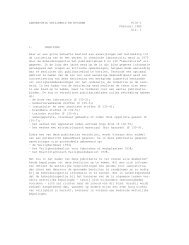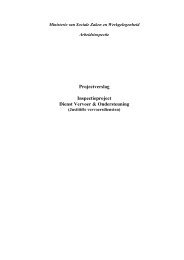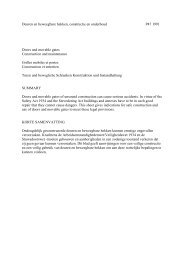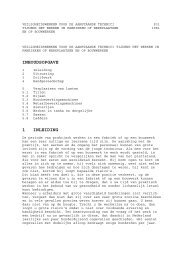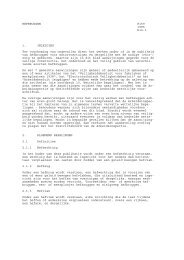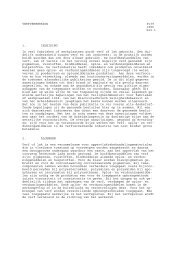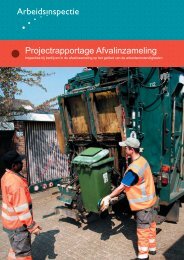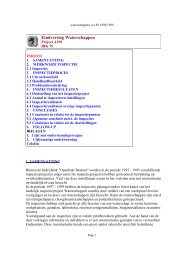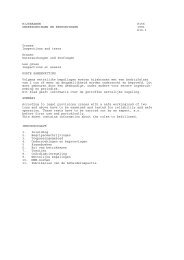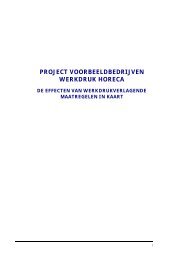Jaarverslag 2003 - Databank Milieu
Jaarverslag 2003 - Databank Milieu
Jaarverslag 2003 - Databank Milieu
Create successful ePaper yourself
Turn your PDF publications into a flip-book with our unique Google optimized e-Paper software.
Table I Number of inspection activities per type of activity and the inspection capacity devoted to these activities in<br />
percentage terms in 2001, 2002 and <strong>2003</strong><br />
2001 2002 <strong>2003</strong><br />
Type of activity Capacity in % Cases Capacity in % Cases Capacity in % Cases<br />
Active OHS 30.5 14,934 36.6 15,271 33 14,276<br />
Complaints 8.3 2,178 8.2 2,167 9 2,052<br />
Accidents 20.3 2,559 18.2 2,481 22 2,211<br />
Labour market 23.5 3,840 17.3 3,737 17 3,700<br />
MHC 5.4 62 4.5 118 9 322<br />
Monitoring 5.1 1,932 5.9 2,771 5 1,879<br />
Other Reactive 6.8 2,031 6.2 1,506 6 1,079<br />
Total 100 27,536 100 28,051 100 25,499<br />
Focus points<br />
Focus points were defined in order to allow the inspectorate to make the<br />
most rational and responsible use of its inspection capacity available for<br />
enforcement tasks in <strong>2003</strong>. In the area of working conditions, these were:<br />
OHS obligations, pressure of work, physical demands, carcinogenic<br />
substances, hazardous substances and noise. In the area of labour market<br />
fraud, they were: the agricultural and horticultural sector, dealing with<br />
people involved in providing illegal labour, dealing with notorious transgressors,<br />
financial investigations and cooperation with other inspectorate<br />
services.<br />
Enforcement in the area of working conditions<br />
Of inspections carried out into working conditions, 58 per cent led to the<br />
setting up by inspectors of an enforcement trajectory following the first<br />
intervention. This had to be repeated in six per cent of the follow-up interventions.<br />
The corresponding figure for 2001 was eleven per cent. This<br />
indicates that the AI’s interventions are becoming more effective over<br />
time, as in a higher number of cases the contravention previously observed<br />
had been resolved by the time of the follow-up intervention.<br />
The most frequently observed contravention was the lack of an up-to-date<br />
risk inventory and assessment, or of a plan of action (21%). Eighteen per<br />
cent of contraventions related to shortcomings in respect of jobs, seventeen<br />
per cent to hazardous substances and twelve per cent to equipment.<br />
There are five different types of enforcement instrument. Warnings and<br />
requirements are the light instruments, while administrative fines, reports<br />
and closure are the heavy instruments.<br />
At the end of <strong>2003</strong>, administrative fines had been available as an enforcement<br />
instrument for working conditions for over four years. Fines are<br />
normally imposed on employers, but employees who behave irresponsibly,<br />
thereby putting themselves or their colleagues in danger, can also<br />
be fined. Fines totalling € 6,797,738 were imposed in <strong>2003</strong>, with 21 employees<br />
being fined a total of € 2,373. From 1 November 1999 to 1 January<br />
2004 the total fines imposed amounted to € 19,089,970, of which<br />
€ 17,515,127 has been paid to date.<br />
During the year under review, a Bill was submitted with a view to introducing<br />
administrative fines into the Foreigner Nationals Employment Act<br />
[Wet arbeid vreemdelingen: WAV].<br />
73



